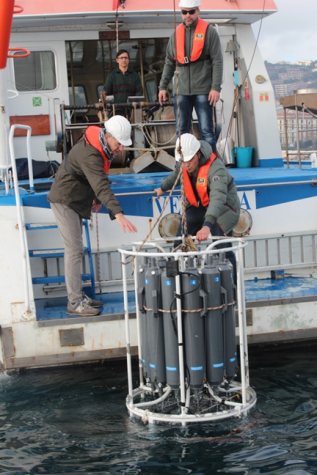
| Descrizione |
L’unità IRM si occupa della raccolta di materiale per la ricerca e per attività divulgative. Il materiale viene raccolto in differenti ambienti costieri, incluso ambiti portuali e lagune, con strumentazioni adeguate o immersioni subacquee. L’attività descritta viene svolta sulla base di un’ampia esperienza sulle specie vegetali o animali richieste, sulla loro distribuzione a scala locale e sul loro ciclo stagionale e riproduttivo, aggiornata attraverso raccolta di informazioni e survey esplorativi. I siti di campionamento e le metodiche vengono prescelti in modo da garantire elevati standard di qualità del materiale raccolto. Si effettuano attività subacquee connesse con l’installazione e la manutenzione di strutture e strumentazioni sommerse. L’unità IRM fornisce anche supporto ad attività finalizzate al recupero, trasporto e liberazione di animali marini. |
| Servizi erogati |
Per poter accedere al servizio, gli utenti interni dovranno compilare e inviare via mail il form ai seguenti indirizzi: fabio.conversano(at)szn.it e francesco.terlizzi(at)szn.it La richiesta andrà effettuata entro il giovedì precedente la settimana in cui si desidera ricevere il materiale. Si invita a prendere visione del regolamento. Gli utenti esterni alla SZN dovranno contattare il Dott. Fabio Conversano. |
| Contatti |
Fabio Conversano Tel. + 39 081 5833357 e-mail: fabio.conversano(at)szn.it |
| Descrizione | Produzione di dati NGS |
| Servizi erogati |
In Progress La tecnologia di sequenziamento di nuova generazione (NGS) sta rivoluzionando il campo delle applicazioni in Biologia Molecolare. Recentemente il servizio si è dotato della tecnologia LIFE TECHNOLOGIES “ION Proton”, in grado di produrre principalmente dati per studi di transcrittomica, di metagenomica, per l’analisi dell’espressione genica e per il risequenziamento mirato. Attualmente, non viene fornita alcuna analisi bioinformatica |
| Attrezzature utilizzate |
Life Technologies ION Proton semiconductor sequencer Life Technologies ION Chef |
| Contatti |
Dr. Elio Biffali Biologia Molecolare e Bioinformatica Tel. +39 081 5833298 e-mail: elio.biffali(at)szn.it |
| Descrizione |
- Microsatelliti per analisi di frammenti (single-locus). - SNiPs, analisi del polimorfismo in un'unica base (single-locus). - AFLP, polimorfismo della lunghezza dei frammenti (multi-locus). |
| Servizi erogati |
Vengono analizzati, ogni anno, circa 6.000 campioni per studi genetici di popolazione, principalmente su piante marine (fanerogame). La genotipizzazione è il processo che permette di identificare il genotipo di un organismo mediante test biologici (genotype testing). Ci sono numerose tecniche che possono essere utilizzate per la genotipizzazione principalmente con un approccio multi-locus o single-locus. Il servizio offre tre differenti approcci analitici: - Microsatelliti (single-locus): L’analisi dei frammenti si ottiene mediante elettroforesi capillare ed è utilizzata per studi di genetica di popolazione, principalmente su piante acquatiche (fanerogame) e alghe. - SNiPs, analisi del polimorfismo in un'unica base (single-locus). L’analisi degli Snips sui campioni è realizzata mediante la tecnologia Snapshot (Life Technologies) che consente, utilizzando l’elettroforesi capillare, con l'uso di un solo oligonucleotide specifico. - AFLP, polimorfismo della lunghezza dei frammenti (multi-locus). La rilevazione è anch’essa realizzata mediante elettroforesi capillare. |
| Attrezzature utilizzate |
Analizzatore automatico di DNA per Elettroforesi Capillare- Life Technologies |
| Contatti |
Dr. Elio Biffali Biologia Molecolare e Bioinformatica Tel. +39 081 5833298 e-mail: elio.biffali(at)szn.it |
| Descrizione |
Il servizio è dotato di un sistema robotico capace di realizzare progetti ad alta produttività per quelle attività di ricerca che necessitano, in tempi brevi, l’analisi di un alto numero di campioni |
| Servizi erogati |
Il servizio è capace di soddisfare differenti richieste: - Allestimentodi reazioni di qPCR e PCR. - Purificazione di reazioni di PCR. - Quantizzazione e normalizzazione di campioni. - Replica, prelievo e riorganizzazione di piastre multipozzetto. - Minipreparazione di DNA plasmidico. - Allestimento e purificazione delle reazioni di sequenza. - Allestimento delle piastre per microsatelliti, AFLP, e SNiPs. - Gestione delle librerie e prelievo dei singoli campioni. - Estrazione di DNA genomico da campioni convenzionali (sangue, code di topo, etc). - Estrazione di DNA genomico da campioni non convenzionali (Ciona intestinalis, Poseidonia Oceanica, Caretta caretta, Cimodocea nodosa, Caulerpa racemosa, Octopus Vulgaris, etc.). - Immunostochimica e ibridazione in situ su embrioni in whole mount (in progress) |
| Attrezzature utilizzate | TECAN HTS platform FREEDOM EVO 200 |
| Contatti |
Dr. Elio Biffali Biologia Molecolare e Bioinformatica Tel.: 081 5833298 e-mail: elio.biffali(at)szn.it |
| Descrizione |
Sequenziamento Sanger di campioni di DNA Il sequenziamento automatizzato del DNA mediante l’elettroforesi capillare rimane uno dei principali ed indispensabili strumenti per lo studio degli acidi nucleici. Le sequenze prodotte sono lunghe in media ~ 650 basi con oltre il 97,5% di precisione, a partire da plasmidi, frammenti di PCR, fagi, etc. La potenzialità del sistema in dotazione al servizio è superiore a 1000 sequenze giornaliere e può sostenere progetti ad alta produttività. Il servizio al momento produce oltre 15.000 sequenze all'anno. |
| Servizi erogati |
1) Sequenze di inserti di DNA clonati in plasmidi (< 15 kb) per ottenere solo le prime informazioni su cloni e subcloni, cioè identità ed orientamento dell’inserto. 2) Sequenze dirette di prodotti di PCR. 3) Sequenziamento fine (double strand) a richiesta e da programmare secondo disponibilità. 4) Shotgun a richiesta e da programmare secondo disponibilità. 5) Gene walking a richiesta e da programmare secondo disponibilità. 6) Transposon-based a richiesta e da programmare secondo disponibilità. 7) Bac ends, lambda-phage, etc. |
| Attrezzature utilizzate |
Analizzatore automatico di DNA per Elettroforesi Capillare Applied Biosystems 3730 DNA Analyzer 48 capillaries - Life Technologies |
| Contatti |
Dr. Elio Biffali Biologia Molecolare e Bioinformatica Tel. +39 081 5833298 e-mail: elio.biffali(at)szn.it |










